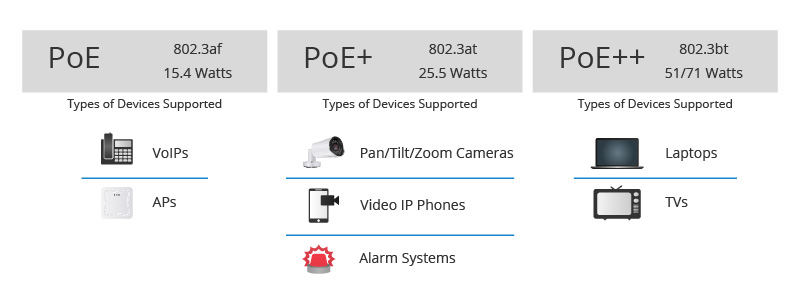What is POE
What is POE and POE Switch
Power over Ethernet (PoE) is a technique for delivering DC power to devices over copper Ethernet cabling, eliminating the need for separate power supplies and outlets.

PoE, or Power over Ethernet, is a proven time-saving and money-saving technology that delivers both data and power safely over the same Ethernet cable for the local area networks (LANs). In the current market, if you take notice of Power over Ethernet switch types, you will find that there are PoE switches, PoE+ switches, and PoE++ switches. But how much do you know about these three PoE switch types? What are their distinctions of PoE vs PoE+ vs PoE++? And how to make a proper selection among them?
What Is PoE and PoE Switch?
What is PoE? PoE technology was defined by the IEEE 802.3af standard in 2003. Under this standard, the PoE allows a PD (powered device) like VoIP phones to receive up to 12.95W PoE wattage, utilizing just two out of the available four twisted pairs in Ethernet cabling.
Then what is a PoE switch? PoE switch refers to an application of PoE technology. Functioning as a kind of PSE (power sourcing equipment), a PoE switch can supply power to PDs via Ethernet cables to realize network connectivity. Generally, an 802.3af switch supports max power consumption up to 15.4W per PoE port with a voltage range between 44V and 57V. And the voltage range of PDs, connected with the PoE switch, is from 37V to 57V.
What Is PoE++ and PoE++ Switch?
In the pursuit of adding more power to broader device applications, the IEEE 802.3 standard once again is required to upgrade its PoE+ technology to PoE++ (IEEE 802.3bt standard) in 2018. PoE++ can be classified into two types: Type 3 and Type 4. Type 3 enables two or all four twisted pairs in a copper cable to deliver power at a PD up to 51W. Type 4 is up to 71W at a PD over four twisted pairs in an Ethernet cable. By the way, Cisco's proprietary technology UPoE (universal Power over Ethernet) works similarly to the PoE++ Type 3, which extends the IEEE PoE+ standard to double the power to a PD to 51 watts. In some cases, UPoE is also called as PoE++. As an upgrade to Power over Ethernet switch and PoE plus switch, PoE++ switch can deliver up to 60W on each PoE port under the Type 3 and up to 100W under the Type 4.
PoE vs. PoE+ vs. PoE++ Switch
Based on the above mentioned introduction, a reference chart that summarizes detailed specifications among PoE vs PoE+ vs PoE++ is presented below image;

Assumed that your data center only requires low standard power levels, you may stick to PoE switches. However, if you'd like to build a more robust and high-performance network with multiple varied devices, plus, don't want to bother to consider the port limitations, then picking PoE+ or PoE++ switches will be the right choice. When starting to build infrastructures of higher requirements or plan for upgrades, take a look at PoE+ or PoE++ technologies may be wiser. However, not everyone needs a full upgrade. If your current PoE solution is adequate and fits your demands, it might be reasonable to remain your existing PoE network design.

